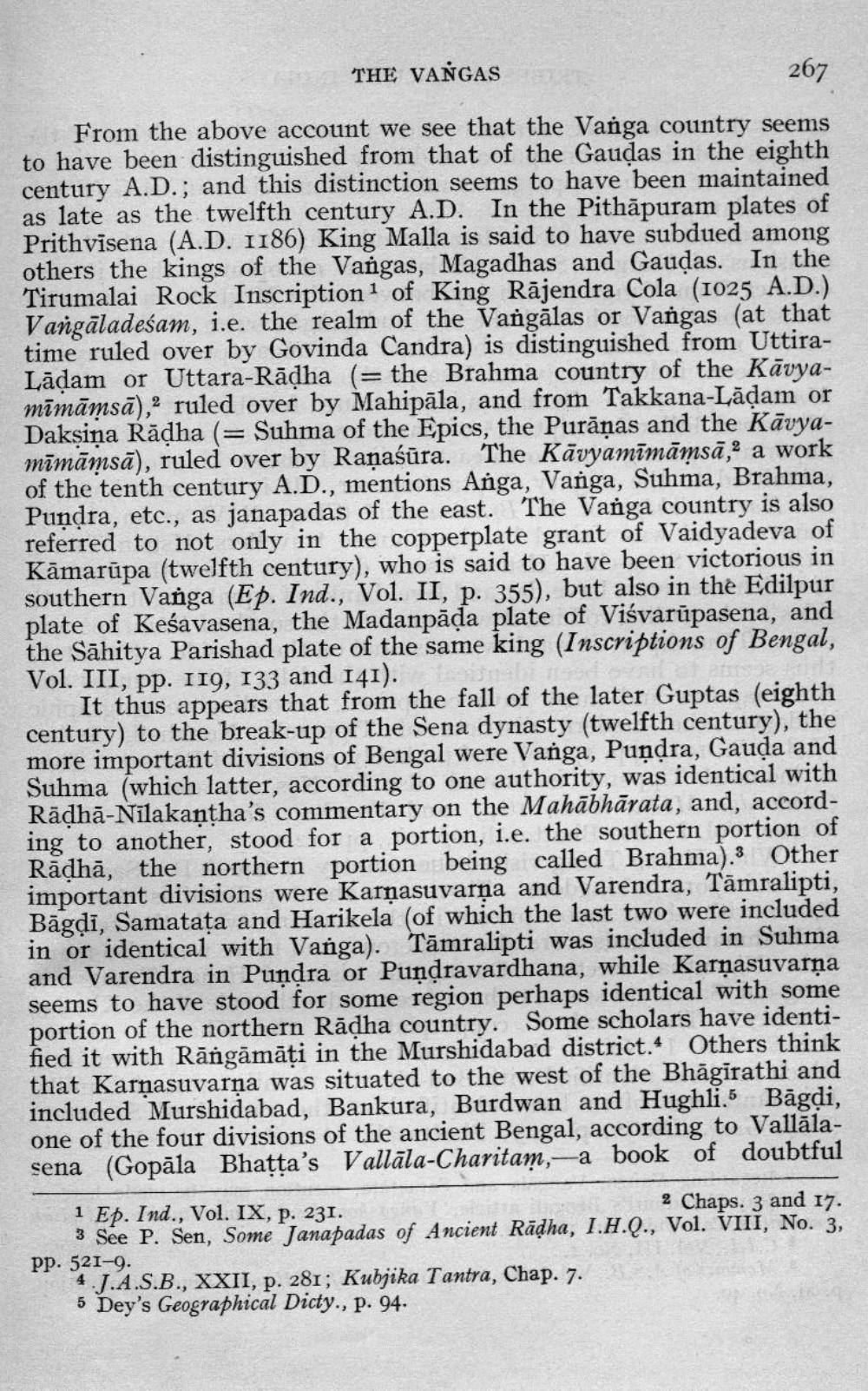________________
THE VANGAS
267 From the above account we see that the Vanga country seems to have been distinguished from that of the Gaudas in the eighth century A.D.; and this distinction seems to have been maintained as late as the twelfth century A.D. In the Pithāpuram plates of Prithvisena (A.D. 1186) King Malla is said to have subdued among others the kings of the Vargas, Magadhas and Gaudas. In the Tirumalai Rock Inscription 1 of King Rājendra Cola (1025 A.D.) Vangāladeśam, i.e. the realm of the Vargālas or Vargas (at that time ruled over by Govinda Candra) is distinguished from UttiraLādam or Uttara-Rādha (= the Brahma country of the Kāvyamīmāmsā), ruled over by Mahipāla, and from Takkana-Lādam or Dakşiņa Rādha (= Suhma of the Epics, the Purāṇas and the Kāvyamīmāmsā), ruled over by Raņaśūra. The Kāvyamīmāmsā, a work of the tenth century A.D., mentions Anga, Varga, Suhma, Brahma, Pundra, etc., as janapadas of the east. The Vanga country is also referred to not only in the copperplate grant of Vaidyadeva of Kāmarūpa (twelfth century), who is said to have been victorious in southern Vanga (Ep. Ind., Vol. II, p. 355), but also in the Edilpur plate of Keśavasena, the Madanpāda plate of Viśvarūpasena, and the Sāhitya Parishad plate of the same king (Inscriptions of Bengal, Vol. III, pp. 119, 133 and 141).
It thus appears that from the fall of the later Guptas (eighth century) to the break-up of the Sena dynasty (twelfth century), the more important divisions of Bengal were Vanga, Pundra, Gauda and Suhma (which latter, according to one authority, was identical with Rādhā-Nīlakantha's commentary on the Mahābhārata, and, according to another, stood for a portion, i.e. the southern portion of Rādhā, the northern portion being called Brahma). Other important divisions were Karņasuvarna and Varendra, Tāmralipti, Bāgdi, Samatata and Harikela (of which the last two were included in or identical with Vanga). Tāmralipti was included in Suhma and Varendra in Pundra or Pundravardhana, while Karņasuvarna seems to have stood for some region perhaps identical with some portion of the northern Rādha country. Some scholars have identified it with Rāngāmāti in the Murshidabad district. Others think that Karņasuvarna was situated to the west of the Bhāgirathi and included Murshidabad, Bankura, Burdwan and Hughli. Bāgdi, one of the four divisions of the ancient Bengal, according to Vallālasena (Gopāla Bhatta's Vallāla-Charitam,-a book of doubtful
1 Ep. Ind., Vol. IX, p. 231.
2 Chaps. 3 and 17. 3 See P. Sen, Some Janapadas of Ancient Rāờha, I.H.Q., Vol. VIII, No. 3, pp. 521-9.
4.J.A.S.B., XXII, p. 281; Kubjika Tantra, Chap. 7. 5 Dey's Geographical Dicty., p. 94.




